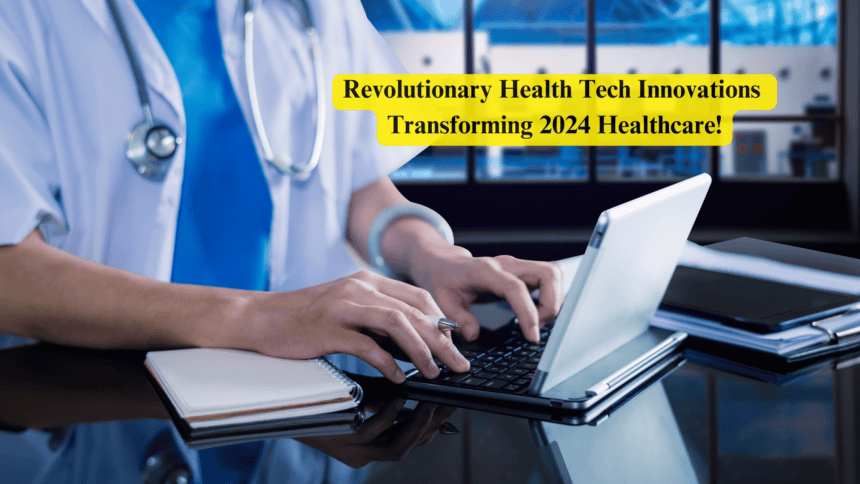Introduction
The Dawn of a New Era in Health Tech
The healthcare landscape is undergoing a seismic shift, driven by relentless technological advancements. These health tech innovations are not merely incremental improvements; they are transformative forces revolutionizing how we understand, diagnose, and treat health conditions. As we delve into 2024, it’s evident that health tech innovations are at the forefront of this metamorphosis, heralding a new era of healthcare delivery and management.
Importance of Health Tech innovations in Modern Healthcare
Health tech innovations enhance the efficiency of healthcare systems, improve patient outcomes, and democratize access to medical services. In a world grappling with chronic diseases, aging populations, and unprecedented healthcare demands, these innovations are not just beneficial—they are essential.
1. Telemedicine and Virtual Care
Evolution of Telemedicine
Telemedicine has evolved from a novel concept to a cornerstone of modern healthcare. Initially utilized for remote consultations, it now encompasses a wide array of services, including remote diagnostics, teletherapy, and virtual follow-ups. The pandemic accelerated its adoption, showcasing its potential to deliver timely medical care without geographical constraints.
Benefits of Virtual Care
Virtual care offers unparalleled convenience, reducing the need for physical visits and minimizing exposure to infectious diseases. It enhances patient engagement, allowing continuous monitoring and prompt interventions. For rural and underserved areas, telemedicine bridges the gap, providing access to specialists and comprehensive care that was previously unattainable.
2. Wearable Health Technology
Rise of Smart Wearables
The proliferation of smart wearables marks a significant leap in personal health monitoring. Devices like fitness trackers, smartwatches, and biosensors have become ubiquitous, empowering individuals to take control of their health. These wearables continuously monitor vital signs, physical activity, and even sleep patterns, offering real-time insights into one’s health status.
Impact on Personal Health Monitoring
Wearables have democratized health data, allowing users to track their health metrics and detect anomalies early. This proactive approach facilitates preventive care, reducing the burden on healthcare systems. Moreover, the integration of AI and machine learning algorithms enhances the predictive capabilities of these devices, making personalized health management more effective.
3. Artificial Intelligence in Diagnostics
AI-Powered Diagnostic Tools
Artificial Intelligence (AI) is revolutionizing diagnostics with its unparalleled ability to analyze vast datasets quickly and accurately. AI-powered tools are now capable of interpreting medical images, identifying patterns, and predicting disease progression. These tools are particularly effective in detecting conditions like cancer, cardiovascular diseases, and neurological disorders.
Enhancing Accuracy and Speed
AI’s precision in diagnostics reduces the likelihood of human error, ensuring more accurate and timely diagnoses. This speed and accuracy are critical in conditions where early detection can significantly impact outcomes. By automating routine diagnostic tasks, AI also frees up healthcare professionals to focus on more complex cases, enhancing overall efficiency.
4. Blockchain for Health Records
Security and Privacy in Health Data
In an era where data breaches are rampant, ensuring the security and privacy of health data is paramount. Blockchain technology offers a robust solution, providing a decentralized and immutable ledger for health records. Each transaction is encrypted and linked to the previous one, making unauthorized access nearly impossible.
Blockchain’s Role in Secure Health Information Exchange
Blockchain facilitates secure health information exchange, ensuring that patient data is accessible only to authorized individuals. This transparency and security foster trust between patients and healthcare providers, enhancing the efficiency of health information systems. Moreover, blockchain’s decentralized nature eliminates the need for intermediaries, streamlining administrative processes and reducing costs.
5. 3D Printing in Medicine
Custom Prosthetics and Implants
3D printing technology has revolutionized the creation of custom prosthetics and implants. Health tech innovations allows for the precise fabrication of medical devices tailored to the unique anatomy of each patient, improving comfort and functionality. The rapid prototyping capabilities of 3D printing also accelerate the development of new medical devices, bringing them to market faster.
Bioprinting and Organ Regeneration
Perhaps the most groundbreaking application of 3D printing is in bioprinting, where living cells are used to create tissues and organs. This technology holds the promise of organ regeneration, potentially addressing the chronic shortage of donor organs. Bioprinting could pave the way for custom-grown organs, eliminating the risk of rejection and saving countless lives.
6. Genomic Medicine
Personalized Medicine Through Genomics
Genomic medicine leverages the power of genetic information to personalize medical treatments. By understanding an individual’s genetic makeup, healthcare providers can tailor therapies to their unique needs, enhancing efficacy and reducing adverse effects. This approach is particularly transformative in oncology, where targeted therapies can significantly improve outcomes.
CRISPR and Gene Editing Technologies
CRISPR, a revolutionary gene-editing technology, allows for precise modifications of the genome. This innovation has vast potential in treating genetic disorders, cancers, and even viral infections. CRISPR’s ability to edit genes with high accuracy opens new frontiers in medicine, making previously incurable conditions treatable.
7. Robotics in Surgery
Advancements in Surgical Robotics
Surgical robotics has seen remarkable advancements, offering unprecedented precision and control. Robotic systems like the Da Vinci Surgical System enable surgeons to perform complex procedures with minimal invasiveness, reducing recovery times and improving outcomes. These systems are particularly beneficial in delicate surgeries, where precision is critical.
Precision and Minimally Invasive Procedures
Robotic surgery enhances precision, allowing for smaller incisions and reduced trauma to surrounding tissues. This minimally invasive approach results in quicker recovery, less pain, and lower risk of complications. As robotic systems become more sophisticated, their applications are expanding, making advanced surgical techniques accessible to more patients.
8. Mental Health Apps
Digital Solutions for Mental Well-being
The rise of mental health apps reflects a growing recognition of the importance of mental well-being. These digital solutions offer a range of services, from meditation and mindfulness exercises to cognitive behavioral therapy (CBT) and mood tracking. They provide accessible, affordable, and stigma-free support for mental health issues.
Popular Apps and Their Effectiveness
Popular mental health apps like Headspace, Calm, and Moodpath have garnered millions of users worldwide. Studies have shown that these apps can effectively reduce symptoms of anxiety, depression, and stress. By incorporating evidence-based practices, they offer a valuable complement to traditional mental health services.
9. Remote Patient Monitoring
Technologies Enabling Continuous Monitoring
Remote patient monitoring (RPM) technologies enable continuous tracking of patients’ health metrics, allowing for real-time interventions. Devices such as wearable sensors, implantable monitors, and smart home systems collect and transmit data to healthcare providers, facilitating proactive care management.
Benefits for Chronic Disease Management
RPM is particularly beneficial for managing chronic diseases like diabetes, hypertension, and heart failure. Continuous monitoring helps detect early signs of deterioration, enabling timely interventions that can prevent hospitalizations and improve quality of life. RPM also empowers patients to take an active role in their care, fostering better health outcomes.
10. Smart Hospitals
Integration of IoT in Healthcare Facilities
The integration of the Internet of Things (IoT) in healthcare facilities is transforming them into smart hospitals. IoT-enabled devices and systems streamline operations, enhance patient care, and improve safety. From smart beds that monitor patients’ vitals to automated medication dispensers, these technologies optimize hospital workflows and reduce errors.
Smart Infrastructure and Patient Care
Smart hospitals leverage advanced infrastructure to provide seamless patient care. Automated systems manage everything from patient admissions to discharge, ensuring a smooth and efficient experience. IoT devices also enable remote monitoring, allowing healthcare providers to keep track of patients’ health status even after they leave the hospital, ensuring continuity of care and reducing readmission rates.
Conclusion
The Future of Health Tech Innovations
As we stand on the cusp of 2024, it is clear that health tech innovations are not just trends but foundational shifts in how healthcare is delivered and experienced. These technologies are breaking down barriers, creating more personalized and effective care, and driving significant improvements in health outcomes. The integration of AI, blockchain, wearable tech, and other cutting-edge advancements is transforming every aspect of healthcare, from diagnostics to treatment to patient care.
Embracing Technological Advancements in Healthcare
To fully realize the potential of these health tech innovations, healthcare systems must embrace change and foster an environment of continuous learning and adaptation. Collaboration between technologists, healthcare providers, policymakers, and patients is crucial to navigate the challenges and harness the benefits of health tech. As we move forward, the commitment to integrating these technologies will not only revolutionize healthcare but also pave the way for a healthier, more connected world.
In conclusion, the top health tech innovations of 2024 are redefining what is possible in healthcare. They promise not only to enhance the quality and accessibility of care but also to fundamentally transform our approach to health and well-being. By embracing these advancements, we are not just improving healthcare; we are shaping a future where technology and humanity work hand in hand for the betterment of all.
For more content follow Humstory.













